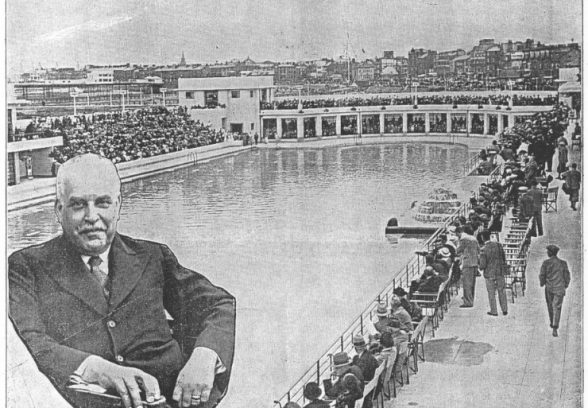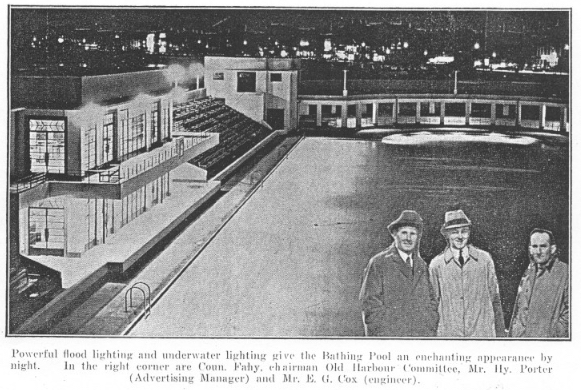This website uses cookies
This website uses cookies to enable it to function properly and to analyse how the website is used. Please click 'Close' to accept and continue using the website.




Super Swimming Stadium, Morecambe
Status: Destroyed
Type: Public building
Architect: Kenneth MB Cross and Cecil Sutton
Location: Morecambe, Lancashire
The Super Swimming Stadium at Morecambe, Lancashire, was one of the grandest of the 1930s modernist seaside lidos. This massive structure measuring 396ft. by 110ft. was said to be the largest outdoor pool in Europe when it opened in 1936, accommodating some 1200 bathers and 3000 spectators. Unusually for an inter-war lido, it was designed not in-house by a Borough Engineer but by two architects, Kenneth MB Cross and Cecil Sutton, who styled it to harmonise with the Streamline Moderne of Oliver Hill’s adjacent Midland Hotel.
The Super Swimming stadium was a grand gesture, intended by the Morecambe Corporation to outdo local rival Blackpool’s huge neo-classical South Shore Swimming Coliseum of 1923 (also now lost). Constructed on the site of TW Ward Ltd’s shipbreaking yard – where holidaymakers once paid 3d for tours of condemned ocean liners – the complex comprised a championship swimming course, water polo area, diving stage, artificial beach for sunbathing, three-deck promenade, two grandstands, a sun terrace, floodlights, a cafe and changing rooms.
Cross and Sutton’s crisp modernism was ideally suited to lido building. The use of steel and concrete permitted large openings between indoor and outdoor space and the huge windows flooded the colonnades with light to create, in the words of Allan Brodie, the “ultimate architectural expression of early twentieth-century attitudes towards health and leisure”. While entirely modern in appearance, only the foundations, frame and roofing were in fact in concrete, the rest being artfully formed from 500,000 reclaimed bricks behind render.
At the peak of the stadium’s popularity it is said to have welcomed some 27,000 swimmers over two days. The appeal of peaceable mass leisure was not lost on contemporaries. When Bank of England governor Sir Josiah Stamp opened the building on 27 July 1936 – days before the Berlin Olympics – he remarked that “bathing reduces rich and poor, high and low, to a common standard of enjoyment and health. When we get down to swimming, we get down to democracy”. After the Second World War, the building hosted national and international swimming and aquatic events as well as pioneering the commercial Miss Great Britain and Miss World beauty contests.
Although the Super Swimming Stadium was a success, it was not without shortcomings. The local council was sued when a young boy slipped on non-slip steps, breaking his two front teeth. A popular complaint was that the stadium tended to be extremely cold as it did not have a roof. More seriously, there was a leak in the sea wall enclosing the basin of the pool which caused seawater to flow in and out with the tide. Apparently it had been present from construction, but it was never located and repair efforts failed. The stadium was closed down in 1975 on grounds of structural problems and demolished just a year later, lost before modern repair techniques and the resurgent public interest in lidos could come to its rescue. The site is now open space.
This text needs adding

Become a C20 member today and help save our modern design heritage.